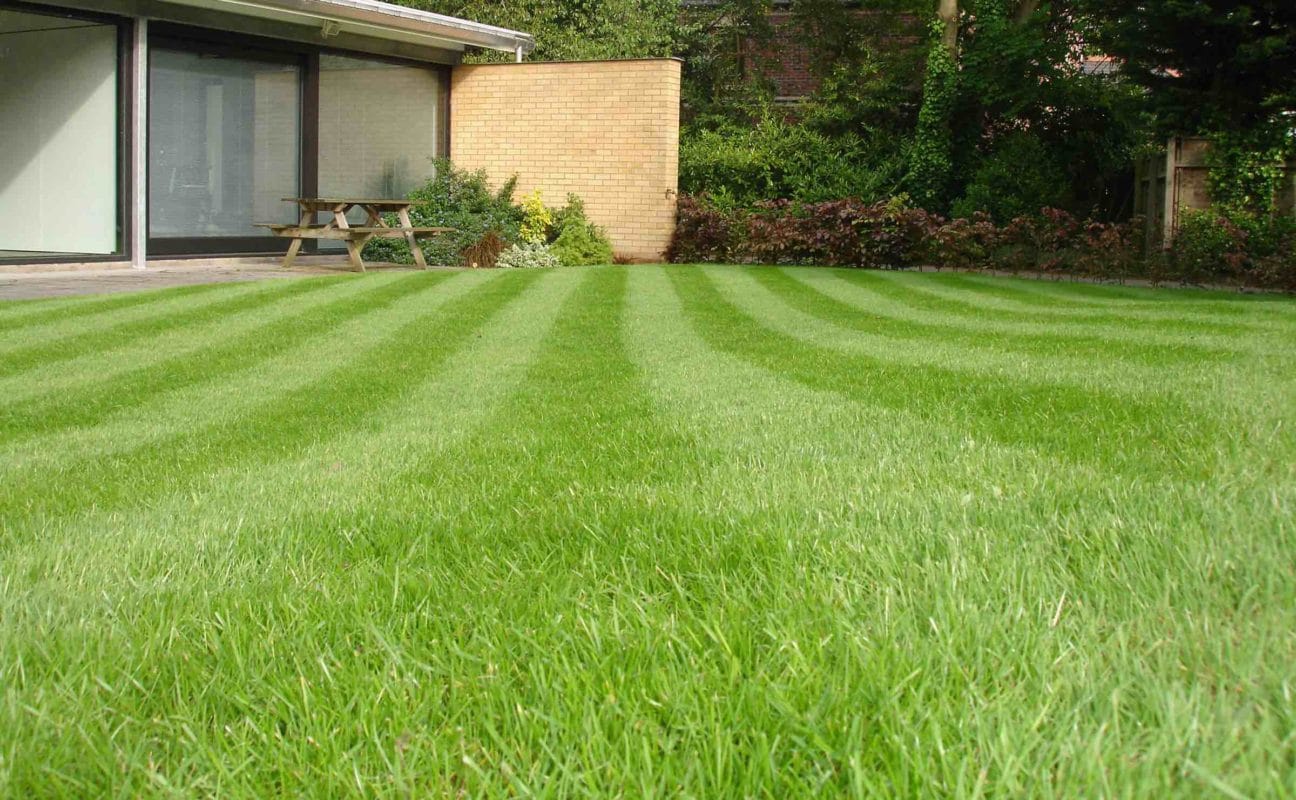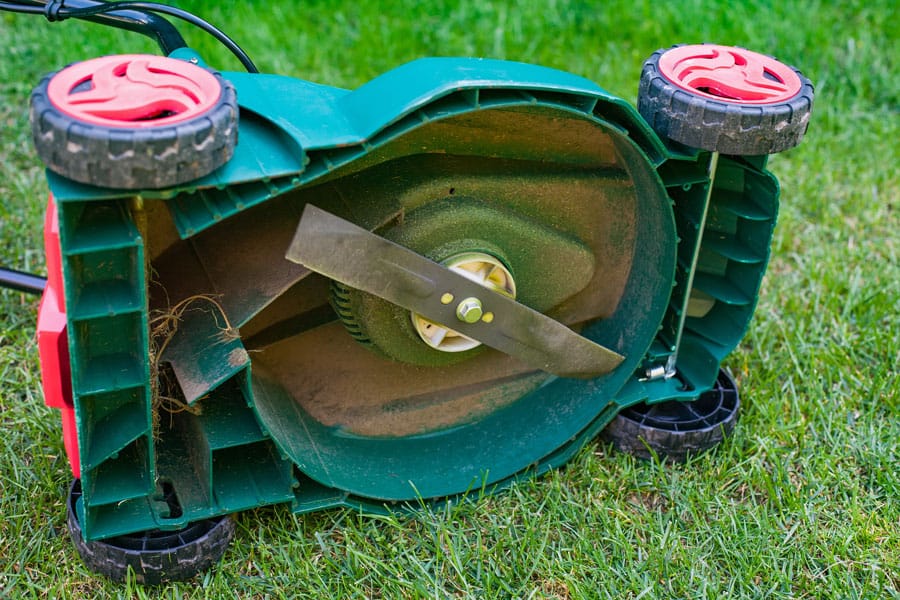Robbie discusses the most common thing that makes lawns fail and explains how you can avoid similar problems in your own garden.
As the owner of a lawn care business and a member of a growing lawn care community, I’m often asked “Robbie, why do lawns fail?” And my answer is nearly always…..because they have the wrong mowing regime.
I believe that many lawn problems can be avoided by having the right mowing regime.
Common lawn problems such as moss, bare patches, weeds and lawn diseases aren’t necessarily caused by bad mowing, but they always seem to be worse when the mowing regime is not quite right.

Mowing little and often helps to cultivate a nice thick sward of healthy grass
How Does Mowing Affect The Health Of A Lawn?
All too often I see lawns fail because the person looking after them is a bit of a last-minute mower. In other words, they put off cutting the grass until it’s unbearably long, and then they scalp it, in the hope that they won’t have to mow again for a few more weeks. They may THINK it’s saving them time, mower fuel etc, but in actual fact, they preparing their lawn for failure. Here’s why.
Survival for a grass plant relies on that plant being able to harvest enough sunlight. It uses sunlight to make the energy it needs for roots and leaves to grow. When a grass plant has plenty of energy, it is better at fighting off disease. Plus, healthy, happy lawn grasses naturally grow so close to the neighbouring grass plant that no moss or weeds can get a look in.
It’s the leaves of lawn grasses that generate the energy needed to keep the plants vibrant and healthy. The bigger the plant in terms of roots, crown and vegetation, the more energy it requires. If we ‘steal’ too much leaf matter when we’re mowing, it will be temporarily weaken the plant. It’s little wonder that lawns fail if they are cut too short too often. After all, people often get ill when they drastically cut their calorie intake – so do lawns.
In a nutshell, lawns fail if gardeners are too brutal with the mower and take away too much of the leaf area in one go.
What Can I Do To Protect My Lawn?
- Mow little and often. Remember the 1/3 rule (see below)
- Keep those mower blades so sharp that they’ll easily slice paper. Blunt blades tear and wound the grass leaves, stressing the plants and make it easier for disease to find a way in
- If your lawn does get a little too long, reduce the height gradually
- Set the mowing height according to the type of grasses in your lawn – not every grass species will tolerate very close mowing.
- Raise the mower blades if grass if you know your lawn is likely to be stressed through heavy footfall, drought or cold weather.
- Regular lawn treatments will replace nutrients lost through mowing and keep your grass looking good
Following The 1/3 Rule
Sensible mowing means sticking to the one third rule. In other words, never trimming more than one third off the length of the grass. Or, to look at it another way, always leaving at least two thirds of the vegetation on the plant. Keen gardeners will also use the 1/3 rule when they are pruning other plants such as Cornus, bush roses and most hedges.

A healthy lawnmower is an important part of maintaining a healthy lawn. Always keep the blades razor sharp and clean them after every cut.
How Low Should You Mow Your Lawn?
Lawns fail when they are mown shorter than the grass species in them can tolerate. If you are new to lawn care or are trying to improve an existing lawn. Try to identify the grass species within that lawn. It’s not always easy to do, but it will give you a clue as to the optimum mowing height for that area.
One grass that I find easy to identify is perennial ryegrass. You’ll find perennial ryegrass in most modern domestic lawns.
What does ryegrass look like? It has two distinctive features. First, compare the two sides of the leaf. If one side is matt and the other side is shiny. The grass is likely to be ryegrass.
Secondly, most ryegrass varieties have a purple tinge at the very base of the grass blade – the paler area where it joins the crown.
The good news is, that if your lawn does have a good proportion of ryegrass, it will tolerate a more relaxed mowing regime. Unfortunately, ryegrass hates being kept really short. It’s just not suited to being maintained like a bowling green.
Robbie’s Recommended Mowing Heights
As a rule of thumb, I find that the following mowing heights work well for me on a sunny lawn with low to moderate foot traffic.
Ryegrass lawn. Spring time, 3-5cm. Hot summer. 5-6 cm. Autumn 4-5cm. Winter 4-5cm.
Fine lawn eg fescues and bent grasses without irrigation: spring – 0.5-2 cm, summer and autumn 1.5 – 3cm Winter 2-3cm
The longer the grass, the better it will tolerate heat, drought and frost. With regular feeding and watering, you can usually maintain a fine lawn at less than 1cm – but it will be labour intensive.
Beware of mowing too short in shaded conditions. Lawns fail when they cannot harvest enough sunshine. If an area is shaded for more than half of the day, you should raise the cutting bar by at least one centimetre. Don’t worry about the grass looking long and straggly. If all of the grass blades are roughly the same length, your lawn will still look fabulous. If you’ve ever seen a field of wheat just before it changes colour, you’ll know what I mean.
Finally, if your lawn is used a lot – for example as a play area, maintaining the grass a little higher will help it to cope with damage caused by feet and paws.
To Summarise
I believe that 93% of lawns fail do so because the mowing regime is not quite right for the type of grass, the level of sunlight and the way they are being used. Feeding, weeding, scarifying and aerating are all important factors in lawn care. But mindful mowing has the biggest influence of all.
You Might Also Like These Articles
Lawn Care On A Budget

